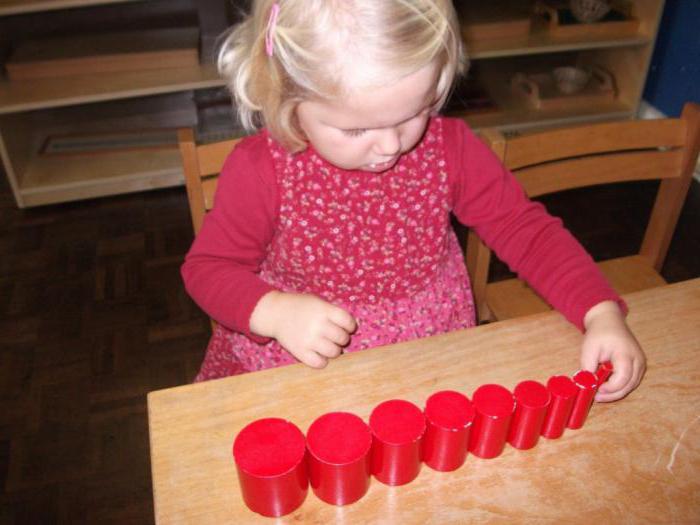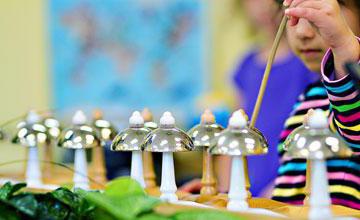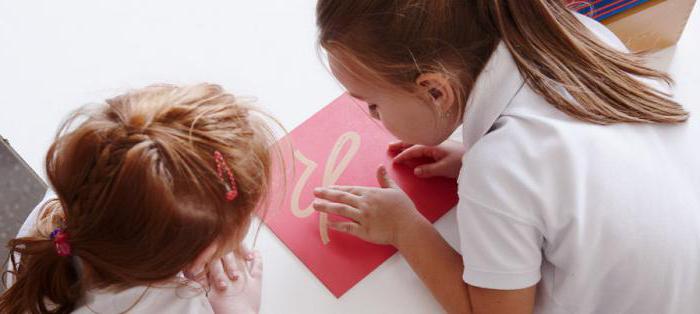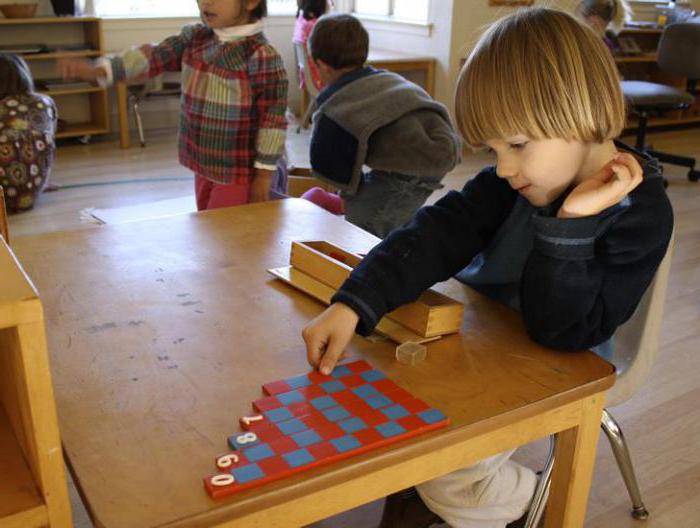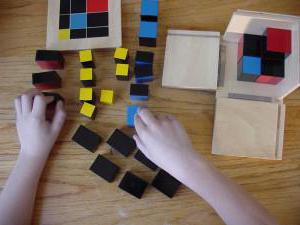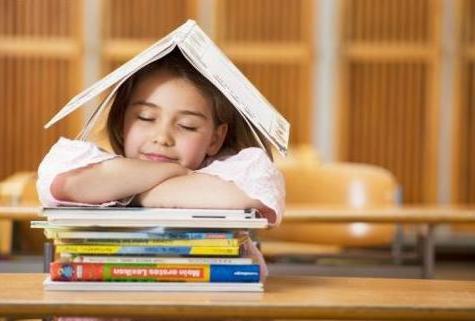One of the most popular methods of child development at the present time is the Montessori system, which implies for children at the same time serious work and an exciting game, discipline and freedom. Maria Montessori, the author of this teaching method, called her " a system where a child develops independently, relying on a didactically prepared environment". The technique exists for more than 100 years, but in Russia for a long time it was not available. The first Montessori books appeared in our country only in the 90s. Today there are many kindergartens and centers early development child working on this system. The Montessori system works with children aged 3 to 6 years.
System history
Maria Montessori was born on August 31, 1870. She was the first woman doctor in Italy, as well as a psychologist, teacher, scientist.
In 1896, Maria worked at a children's clinic, and her attention was drawn to the unhappy mentally retarded children who, not knowing what to do, wandered aimlessly through the echoing hospital corridors. Observing their behavior, Maria concluded that this is the result of a lack of developmental stimuli, and that every child needs a special developing environment in which she can learn something interesting for herself. Purposefully and in depth doing psychology and pedagogy, Maria tried to develop her own methods for the upbringing and development of children.
On January 6, 1907, Maria Montessori opened the “Children's Home” in Rome, where the educational system created by her was used for the first time. Moving by trial and error, Maria prepared sensory materials that stimulate children's cognitive interest. Since 1909, the Montessori books began to spread throughout the world, in 1913 they reached Russia. In 1914, the first kindergartens according to the Maria Montessori system began to open, but with the coming of the Bolsheviks to power, they were closed. The return of the Montessori method to our country took place only in 1992.
Based on knowledge of the features of the physiological, mental and psychological development of children, Maria Montessori concluded that education is not so much a teacher’s responsibility as a natural process of the development of a child.
The essence of the Montessori method
Montessori method is a unique author's system of self-development and self-education of children. The key attention here is drawn to the development of fine motor skills, feelings (sight, hearing, taste, smell, touch), as well as the education of independence in the child. There are no uniform programs and requirements; an individual pace is provided for each child. Every kid is free to do what he likes. Thus, he “competes” with himself, gaining confidence in himself, as well as fully assimilating the material.
The key principle in Montessori pedagogy is “Help me do it myself”. That is, an adult has to figure out what the baby is interested in, provide him with an appropriate learning environment and teach the child to use it. An adult helps a child to reveal the abilities inherent in it by nature, as well as to go through their own path of development. Note that the pupils of the Montessori system are inquisitive children, open for learning. They grow up independent, free, they know how to find their place in society.
Basic provisions of the Montessori system
- Child's activity. An adult plays a minor role in teaching a child, being not a mentor, but an assistant.
- Freedom of action and the choice of the child.
- Older children teach younger ones. In doing so, they themselves learn to care for the younger ones. This is possible because, according to the Montessori pedagogy, groups are formed from children of different ages.
- The child makes decisions independently.
- Classes are held in a specially prepared environment.
- The task of an adult is to interest the child. Next baby develops himself.
- In order for a child to develop fully, it is necessary to provide him with the freedom of thinking, actions and feelings.
- You should not go against the instructions of nature, you need to follow these instructions, then the child will be himself.
- Invalid criticism, inadmissible prohibitions.
- The child has the right to make a mistake. He is quite capable of getting to it all himself.
Thus, the Montessori system stimulates in the child the desire for the development of its potential, for self-learning and self-education. In this case, the responsibility of the caregiver is to organize the activities of the children, while offering help exactly to the extent necessary for the child to become interested. So, the main components of Montessori pedagogy, allowing kids to realize their own path of development, are:
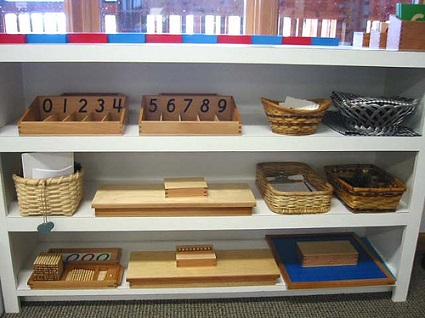
The role of an adult in the system
It may seem that the role of an adult in this method is insignificant, but this is only at first glance. The teacher must have the wisdom, natural flair, experience to feel the system. He must carry out serious preparatory work to create a real development environment, and also provide pupils with effective didactic material.
Maria Montessori believes that the main task of an adult is to help a child collect, analyze and systematize his (child) own knowledge. That is, adults do not pass on their own knowledge of the world. It is understood that the tutor should carefully observe the actions of the children, identify their interests, inclinations, provide tasks of varying degrees of complexity with the didactic material that the child himself chooses. It is assumed that an adult should be with the pupil on the same level - that is, sit on the floor or squatting next to him.
The work of the educator is as follows. First, he watches what material the child chooses, or helps him become interested. Then shows how to cope with the task, while being as laconic as possible. After that, the child plays on his own, he may be wrong, but at the same time invent new ways to use the selected material.Such creative activity of the child, according to Montessori, allows him to make great discoveries. The task of an adult is not to interfere with these discoveries, since even a small remark can confuse the child and prevent his further movement in the right direction.
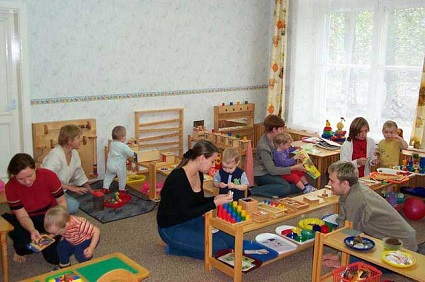
The role of the developing environment in the Montessori system
The most important element in Montessori pedagogy is the developing environment. You could even say the key element. Without it, the technique can not exist. Properly prepared environment helps the child to develop independently without educational care, teaches him to be independent. Children have a great need for knowledge of the surrounding world, they want to sniff everything around, feel, taste. The path of the child to the intellect lies through the senses; therefore, sensation and knowledge merge together for him. The right environment is an environment that meets the needs of the child.. The process of development of children should not be accelerated, but you also need to be very careful to prevent the child from losing interest in this or that activity.
The developing environment is built according to a strictly defined logic. Traditionally, there are 5 zones:
- Exercise zone in everyday life. Here the child learns how to handle his things, as well as how to look after himself.
- Native language zone. Allows you to expand vocabulary, get acquainted with the letters, phonetics, understand the composition and spelling of words.
- Zone sensory education. Develops the senses, provides the opportunity to study the shape, size, size of objects.
- Space Zone. Acquaints with the outside world, with the basics of anatomy, botany, zoology, geography, astronomy, physics.
- Mathematical zone. Teaches the understanding of numbers, the order of the account, the composition of numbers, as well as the basic mathematical operations - addition, subtraction, multiplication and division.
Tables in the room are missing, there are only small tables and chairs, moved at its discretion, as well as rugs. Children can lay them where they are comfortable.
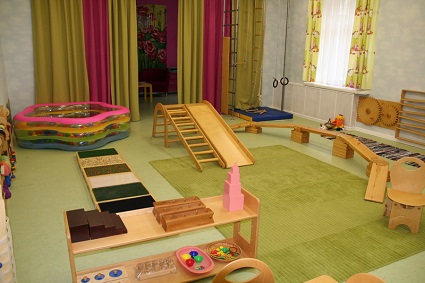
The role of didactic material in the Montessori system
Child learning is closely related in the Montessori system with subject matter. At the same time, practically any objects can act as toys. A basin, water, tea strainer, napkin, cereal, spoon or sponge can become a toy. There are also special montessori materials, in particular, the Pink Tower, liners, Brown Stairs and others. The manuals by Maria Montessori were designed with the utmost care. They were supposed to carry the learning task, as well as contribute to the full development of the pupils.
Any classes with didactic materials have a direct and indirect goal. A direct goal actualizes the movement of the child, indirectly develops hearing, sight, and coordination of movements. Since the intervention of an adult according to Montessori pedagogy must be minimized, the materials are designed in such a way that the child can find his own error and correct it. So the kid learns to prevent mistakes. The benefits are absolutely available for children, it encourages them to explore.
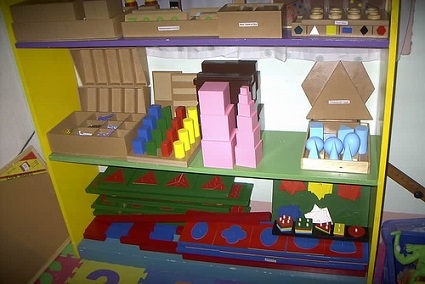
Rules for working with didactic material
- To encourage the child to act, the material should be placed at the level of his eyes (not higher than 1 meter from the floor).
- The material must be treated carefully. The material can be used by the child after the adult explains to the baby its purpose.
- When working with the material, the following sequence should be followed: selection of the material, preparation of the workplace, execution of actions, control, correction of errors, return of the benefit to the place upon completion of work with it.
- It is forbidden to transfer benefits from hand to hand during group lessons.
- The material in a certain order must be laid out by the child on a table or rug.
- The child can interact with the material not only following the example of the caregiver, but also taking into account his own knowledge.
- Work should gradually become more complex.
- After completing the exercises, the child must return the allowance to the place, and only after that he can take other materials.
- One child works with one material. It allows you to focus. If the material that the kid has chosen is currently busy, you should expect to watch the work of your peer, or choose any other.
Maria Montessori notes that these rules do not apply to collective games aimed at developing communication and cooperation skills.
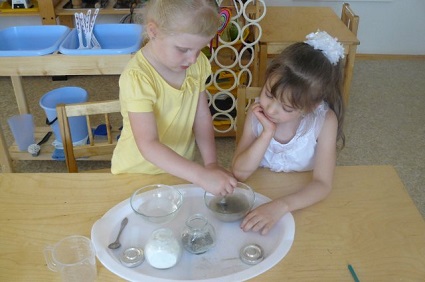
Cons of the Montessori technique
Like any pedagogical system, the Montessori method has several disadvantages.
- The system develops only intelligence and practical skills.
- There are no motion and role games.
- Denied creativity. It sees an obstacle to mental development child (although psychological studies suggest the opposite). However, in Montessori Gardens there are special game rooms, and the child does not spend all the time in the kindergarten. This allows you to partially compensate for the last two deficiencies.
- The Montessori system is quite democratic. After her children can be difficult to get used to the discipline of ordinary kindergartens and schools.
In a single article to fit the whole Montessori experience, reflected in its educational systemis impossible. We have tried to present in this article the basic postulates. For more detailed information on the methodology, we recommend referring to the original sources, books written by Maria Montessori and her followers. Fortunately, at present there is access to various pedagogical systems and methods, which allows us to choose the best for our children.
INTRODUCTION ................................................. .................................................. .......... 3
1. The main ideas of Montessori pedagogy ............................................ ........five
2. Ideas M. Montessori in kindergarten ......................................... .................9
3. Features of the development of Montessori ideas in Belarus and their influence
on public preschool education .............................................. ..12
CONCLUSION ……………………………………………………………………… .15
LIST OF LITERATURE …………………………………………………………… .16
Introduction
Preschool education lays the foundation of the personality, contributes to the disclosure of the child’s abilities throughout his later life. The system of preschool education solves the problem of teaching a child life in society, acquaintance with the basic laws of life and nature, and preparing him for school.
Harmoniously arranged training and the life of a child in kindergarten will allow them to realize their potential, starting from an early age.
Therefore, teachers of preschool education seek to use in their practice the systems most naturally suitable for children, taking into account their age features, curiosity and desire to learn the world in all its diversity.
The well-known pedagogical system of Maria Montessori lies at the heart of many existing systems for the upbringing of young children. It is based on an individual approach to the child: the child chooses didactic material himself and the duration of classes, develops in his own rhythm.
For nearly a hundred years, the name of Maria Montessori has attracted the unrelenting attention of teachers and scholars in more than eighty countries around the world. Known as an eminent scientist and humanist, she created a system that was not equal in world experience. Europe, America, India, China, Japan - thousands of Montessori schools are open all over the world.
Purpose of the study - to consider the essence of the Montessori pedagogical system and the possibility of its practical application in preschool education in Belarus.
Object of study: pedagogical system M. Montessori.
Subject of study: features of the development of the ideas of M. Montessori in Belarus.
To achieve the goal of the study in the work are the following tasks:
1. To study the basics of the Montessori pedagogical system.
2. To consider the process of implementing the ideas of M. Montessori in kindergarten.
3. To analyze the features of the development of Montessori ideas in Belarus and their influence on public pre-school education.
1. The main ideas of Montessori pedagogy
Let's start with a small historical background of the founder of pedagogy, which has become known in many countries. Maria Montessori was born on August 31, 1870 in Italy, and died in 1952 in Holland. She was the first woman doctor in Italy, worked as an assistant in a psychiatric clinic, taught at the University of Rome, and only after receiving a doctorate in philosophy, she founded the Children's Home in one of the poor neighborhoods of Rome.
It was about this “House of the Child” that she later wrote a unique work “House of the Child. The method of scientific pedagogy.
M. Montessori called her pedagogical system the child's self-development system in a didactically prepared environment. Studying the life course of a child passing in close proximity to adults, it was the study, and not the interference with its educational methods and principles, that it used as the basis for pedagogical anthropology.
M. Montessori believed that any practical actions, theories and models can be built only on the fundamental knowledge of a developing person. Scientific observations of the state and behavior of children helped her discover the “phenomenon of polarization of attention,” from which, in fact, she draws conclusions about the child’s free self-development and how to organize her work in a specially equipped environment.
One of the significant works of Maria Montessori is called “Children are Others”. Already in the title of the book one can see its principled view on the picture of the life of a child. It lies in the fact that the psyche and the very essence of the child is arranged differently than in adults.
If adults acquire knowledge through analysis and synthesis of what is happening, then the child simply absorbs life as a whole. The little child has no memory, first he needs to build it. The child experiences time differently than adults. The natural rhythm of his life is much slower. He lives by what happens to him at a particular moment, while adults constantly plan their lives, highlighting the most urgent and necessary things.
Young children learn primarily through their own actions. Adults can learn the world by reading, observing, perceiving information by ear. But every adult feels the difference between the story of the event and direct participation in it. Kids learn the world through the prism of their own feelings, lived in action.
The child constantly imitates adults who are close to him, but at the same time, the desire to be independent is one of the most powerful feelings of childhood. In contrast to an adult, the child’s interest and feeling of real satisfaction does not result in a child, but in the process of independently performing targeted actions.
“One of the most important anthropological observations of Maria Montessori was the determination in the mental life of a child of special periods of the most intense susceptibility of certain manifestations of life.” In the case of animals, the English geneticist Arnold Gisl and the Dutch biologist Hugh de Vries tried to determine similar periods at the end of the 19th century. They proved that the maturation of the functions of the human psyche can occur only through the development of the external world, which proceeds differently at different stages of development, because in the process of growth, the vital forces of the child (orme) change their structure. These periods of intense maturation of the psyche, scientists call the sensitive phases of development.
Montessori observed similar phases in young children. “Based on this susceptibility, the child is able to create a particularly intense relationship between himself and the outside world, and from this point of view, everything becomes easy for him, inspiring, alive. Every effort turns into an increase in strength ... As soon as one of these spiritual attachments weakens, another flame is ignited, and so the child moves from one victory to another, in the unceasing vibrations of the life force that we know and which we call "the joy and happiness of childhood."
It is clear that it is possible to achieve results in the development of a child and, without paying attention to sensitive periods of his growth, but this will require a great deal of effort from the adult, will, labor and tension. At that time, at the moment of the sensitive phase, a spontaneous learning process is initiated, that is, the environment itself makes possible the action of the creative potential of the child and the acquisition of life experience. A game of exchange takes place, as it were: biological maturity comes from one side through the environment, and from the other through a continuous movement of consciousness.
Maria Montessori identified several such sensitive phases.
The first stage in the development of a child (up to 3 years) is defined by Montessori as learning basic sensory skills - walking, the basics of moving in space, and communication skills.
The second stage - from 3 to 6 years. "This is a period of" absorbing consciousness, "linguistic, sensory development."
Montessori also identified a sensitive order phase in children, which, according to Montessori’s observations, lasts in children from birth to about 4 years. The highest point is observed at 2 - 2.5 years (the child requires external order in his environment, puts objects in place, almost ritually performs actions). During this period, his life is subject to a certain external and internal rhythm. Montessori writes about that in the early childhood the human soul recognizes its surroundings, at first being guided by the elements, and subsequently conquers this surroundings only as needed. That is why it is important not to miss the period of order in the development of the child.
Maria Montessori attributed the phase of development of movements, language, feelings, social skills, and interest to small things to other phases of children's susceptibility.
A feature of the Montessori system is the direct interaction of the child with the teaching material (see Figure 1).
DIV_ADBLOCK146 "\u003e
All toys dolls, cubes, cars are here, in one of the corners, and if the kid wants to play with them without disturbing the others, he calmly dresses up or feeds the doll, builds a garage for his cars from the cubes. You can dress in adult clothes that are folded in a special basket or do hair in front of a mirror.
With the fact that there is an opportunity to play in ordinary toys, most children are busy exploring the world with the help of special teaching aids.
The attractiveness of the didactic material captures children so much that they prefer to put their doll on the edge of the mat and lay out here the decimal system of beads of golden material.
In independent free work small child daily materializes the natural need to refine their feelings, actions, and concentration. Such work does not tire him, no matter how long it lasts, because in natural life there can be no stopping. Still, two hours after the start of free work, the children hear the sound of quiet music - a sign of gathering for the general circle. The begun work comes to an end, materials are put on regiments.
Each circle has its own context, which depends on the living situation. Many circles are associated with a discussion of events occurring in the lives of children at home and in kindergarten. In other tutor tells the tale. In the fall, children collectively look at fruits and vegetables, taste them, learn to grind grain and knead dough. In winter, they study the properties of water, melting snow over a candle, or learn Christmas songs. Birthdays of children and other important events are also celebrated here. They recall that one of the children fell ill or someone had to go to the dentist for an unpleasant trip.
Fifteen minutes of the general circle fits: personal children's problems, calendar, history, geography, biology, mathematics and literature, pantomime and theater.
The circle is always led by the teacher, but he only helps the general conversation. The child has the right of independent expression, an attempt to explain his experience to others. The teacher here scores his words. He professionally provokes an inflaming bonfire of a general conversation, in which each of the children throws up his sliver. The circle ends in fifteen minutes.
After the circle of children waiting for lunch and daytime sleep in a special room for rest. After sleep, the children walk and continue their studies and games in the group.
Thus, most often the daily routine in the Montessori group is as follows.
8.00 - Reception of children, breakfast
8.30 – 11.00 - Classes in the Montessori class. A circle
11.00 – 12.10 - Stroll
12.10 – 13.00 - Lunch
13.00 – 15.00 - Daytime sleep
15.30 - afternoon tea
16.00 – 16.30 - Occupations (work on the line, choreography, music, physiotherapy, drawing, English.)
16.30 – 17.30 - Stroll
17.30 – 18.00 - Outdoor games, reading books
This is the usual routine for a Montessori kindergarten. Educators at the request of parents and children can make their own changes to this schedule. But in general, it is the immutability of this schedule that makes it valuable from the point of view of the Montessori system itself, in which one of the basic tenets is the child’s internal desire for order.
3. Features of the development of Montessori ideas in Belarus and their impact on public pre-school education
In Belarus, Montessori pedagogy began to actively develop since 1991. One of the first in Belarus in the early 90s the Montessori methods began to use the Brest kindergarten No. 40 and the Minsk No. 000. In 2000, the Maria Montessori system in Belarus was introduced as a republican experiment, then as innovative platforms in the districts. Since 2000, Minsk kindergarten № 000 became the basic urban experimental platform for the implementation of the Maria Montessori pedagogical system
Montessori groups today operate in Gomel, Mozyr, Zhlobin, Mogilev, Minsk, Rechitsa, Dobrush, Zhitkovichi and Vetka.
Once a year, a seminar “Realization of the ideas of the Maria Montessori pedagogical system in a modern pre-school institution” is held in Svetlogorsk for teachers and educators of the pre-school institutions of the Gomel region working on the Maria Montessori system. The venue of the regional seminar event is Kindergarten No. 4 “Teremok” - the only preschool institution in the region that has three Montessori groups at once.
Seminar participants familiarize themselves with the history of the creation of Montessori groups in Svetlogorsk, learn in practice the complex “On the Circle” lesson, the work of children with Montessori materials.
Teachers believe that the Montessori system successfully implements the republican pre-school education program with its own means.
“Popularizing the experience of one preschool, it is hoped that those elements that the caregivers introduce here will grow into a deep and lasting assimilation of technology in the field. ”
At the moment, several gardens work in the Montessori system in Minsk. Here, for example, how the work of the Minsk kindergarten number 000 is arranged.
The practical life zone is equipped with fairly simple and at the same time useful materials for work.
Frames with a certain “fragment” of a shirt with buttons and other types of fasteners, a “methodical” shoe for learning to tie shoelaces, a real kitchen sink, where real soap can be washed with real soap. The usual electric stove, on which the children themselves can bake pancakes - of course, under the guidance of an educator, but with their own hands.
The area of \u200b\u200bsensory development, where the child learns to determine the height, length, weight, color, sound, smell, temperature of objects. There are linguistic, mathematical, geographical, natural science zones. There are no classes as such: each child can choose a business for himself, and the task of the educator is to coordinate these classes.
Groups in Belarusian kindergartens, as a rule, are of different ages, as provided for by the Montessori system (from 3 to 6 years), and younger children quickly and eagerly learn from their elders, the older ones feel responsibility for the younger ones.
In each group there is a “quiet corner”: a place enclosed by curtains with a cozy sofa, TV, player and records, bookshelf and diascope. If the child suddenly became sad or wanted to be alone, he can retire in this corner.
There are also kindergartens that the Montessori system is very successfully used in working with children with mental development and cerebral palsy, for example, Minsk kindergarten number 000.
The main problems faced by kindergartens wishing to work on the Montessori system are financing problems. Methodical materials for this system are quite expensive. In addition, the full implementation of the Montessori program requires not only the acquisition of materials, but also special furniture for groups. In this regard, almost all working groups work with the support of parents or on a commercial basis.
Also, the problem of introducing Montessori ideas was the existing prejudice that children who were brought up according to the Montessori method in kindergartens had problems in a regular school. In some ways, such a position has the right to exist. The fact is that Montessori children are more independent, and the habit of learning everything by oneself and relying on one’s own strength, instilled in a kindergarten, can give them some discomfort. As, however, the need for a lesson to listen to the teacher (as mentioned above, classes in montessori groups last only a few minutes). However, it all depends on the particular child and his character.
Conclusion
A key feature of the Montessori methodology is the creation of a special developmental environment in which the child will be able and willing to show their individual abilities. Montessori classes are not like a traditional lesson. Montessori materials allow the child to see and correct their own mistakes. The role of the Montessori teacher is not to learn, but to manage the child’s independent activities.
The Montessori technique helps to develop attention, creative and logical thinking, memory, speech, imagination, motor skills. The Montessori Methodology pays special attention to the collective games and tasks that help to master the skills of communication, as well as the development of household activities, which contributes to the development of independence.
In the method, exercises used in practical life, some of which come from everyday household chores, are common. The activity of the child is observed by adults. In the future, he develops a sense of self-esteem and independence, since now the vital activity can be carried out by him completely independently. The materials for exercise in everyday practical life should meet children's needs in color, shape, size, convenience and attractiveness.
In Belarus, Montessori ideas are quite widespread in the system of preschool education. Budgetary kindergartens, fully working on the Montessori methods are not. However, in some kindergartens there are groups in which Montessori techniques are used. They become more every year, but demand exceeds supply several times. Also, some kindergartens use elements of the Montessori method.
BIBLIOGRAPHY
1. The harmonic atmosphere of Montessori. // Pre-school education. 2000. - № 11. - p. 47.
2. Minin V. // http: // www. / plus / viewrp. php? id \u003d 1951
3. Montessori M. "Help me to do it myself" // Compilers, (collection of fragments from M. Montessori's translated books and articles by Russian authors about pedagogy by M. Montessori). PH "Karapuz". M. 2000. - p. 84.
4. Montessori M. Children - others. PH "Karapuz". M. 2004.
5. Montessori. M // Compiled by, (collection of published fragments of books by M. Montessori) 1999 .: Publishing House Shalva Aminashvili - 224 p.
6. Montessori M. About the principles of my school. Per. from English V. Zlatopolsky // Teacher's newspaper gazetavgusta. - C.4.
7. Montessori M. Method of scientific pedagogy, applied to children's education in children's homes. - M .: Type. Gossnab, 19c.
8. Montessori M. Development of human potential. Per. from English D. Smolyakova. // Bulletin MOM number 2, 3.5. 1993.
9. Sergeyko reformatory pedagogy. Grodno. 2001. - 284 s.
10. Fausek U. "Pedagogy of Maria Montessori". M .: 2007. - 203 p.
Montessori, M. Children - other / M. Montessori. - M .: Publishing House "Karapuz", 2004. - 336 p.
Lyubina, G. The harmonic atmosphere of the Montessori / G. Lyubina // Preschool education. 2000. - № 11. - P.47-52.
Montessori, M. “Help me to do it myself” / M. Montessori // Comp. , (collection of fragments from translated books by M. Montessori and articles by Russian authors on the pedagogy of M. Montessori). - M .: Publishing House "Karapuz", 2000. - 272 p., P.84.
Sergeyko, reformist pedagogy. - Grodno: GrSU, 2001. - 306 p., P. 177.
Romantsov, V. Elite Pedagogy - in Svetlogorsk / V. Romantsov // http: // www. / plus / viewrp. php? id \u003d 1951
In modern pedagogy, parents will be able to find many copyright methods of raising a child from the cradle. However, the development program of the Italian scientist Maria Montessori is rightly considered the most demanded. Her method, of course, with an eye on new achievements in pedagogy, is actively used in numerous development centers and kindergartens in many countries of the world. What is the secret of such popularity?
A bit of history ...
The founder of the well-known technique is the first woman in Italy who has mastered the profession of a doctor. Working with children with developmental disabilities, the author developed her own rehabilitation course, which was highly appreciated in the educational environment.
In 1907, for the first time, the Children's House opened its doors for healthy preschoolers and schoolchildren. It was in this institution that the same technique that we are talking about today was applied.
In the future, the method became widely known - Montessori read a large number of lectures, released several unique books and a lot of teaching aids. Around the world, preschool educational institutions appeared in which tutors used this method, and a little later experimental schools appeared. For more than a hundred years, it has remained at the peak of popularity among parents and teachers.
The essence of Montessori pedagogy
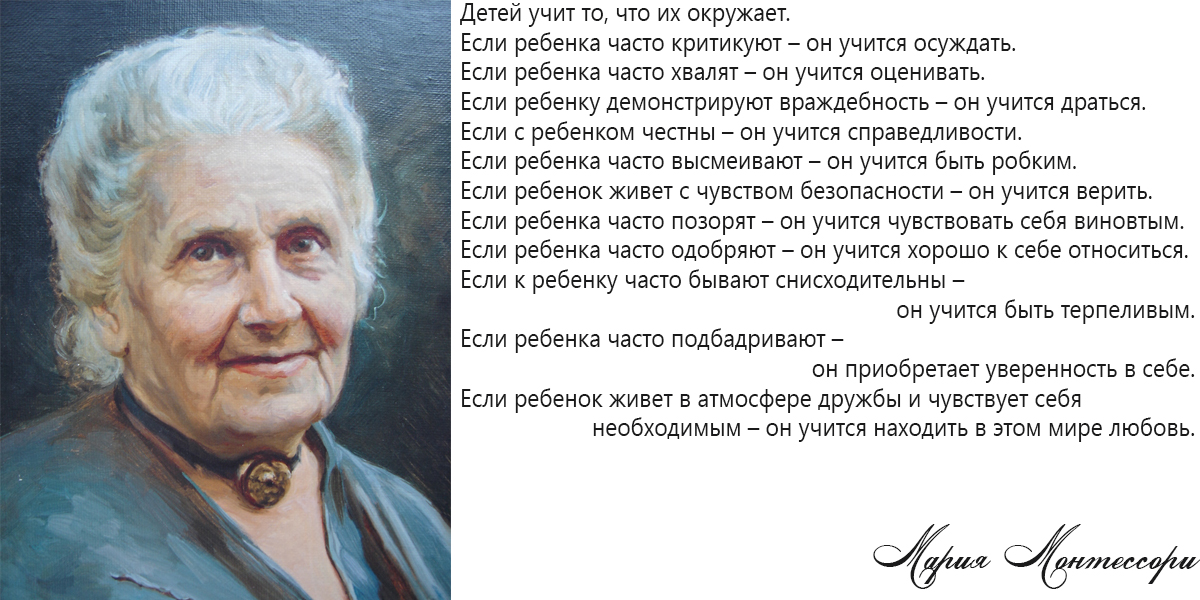
Perhaps the main principle of this method is the idea of \u200b\u200bself-education of the baby. Parents and caregivers need to understand what is interesting for the child, create the necessary developmental conditions and explain how to get knowledge. Hence the motto of the educational system: “Help me do it myself!” .
Key points:
- Classes are held in a specially organized environment, divided into several zones (we will tell about them a little later), in which work aids are conveniently placed.
- In groups, preschoolers of different ages are involved: the older ones take care of the little children, and they, in turn, try to learn from older children.
- Teachers should not impose anything on the child, he himself decides that he is interested in (bathing pupsika, painting or playing with frame inserts), how much time he spends, whether he becomes engaged alone or in company.
However, one should not think that permissiveness thrives in groups and classes. Children are taught to follow the following rules:
- What the child can do on his own, he performs without the participation of the teacher or parent. It develops independence, self-reliance.
- Children should keep quiet, do not disturb others from playing and practicing. However, they can "let off steam" in special rooms for relaxation.
- All toys, cubes and stationery with which the kids interact, they must wash, fold and put into place. It develops in children respect for other people.
- The one who first took the doll or liners, and deals with these benefits. In this way, children develop an understanding of their own and others' boundaries.
Compliance with the rules, organizing activities brings stability to children's life, allows preschoolers to feel more confident, fosters patience and respect for peers and adults.
What is special about Montessori classes?
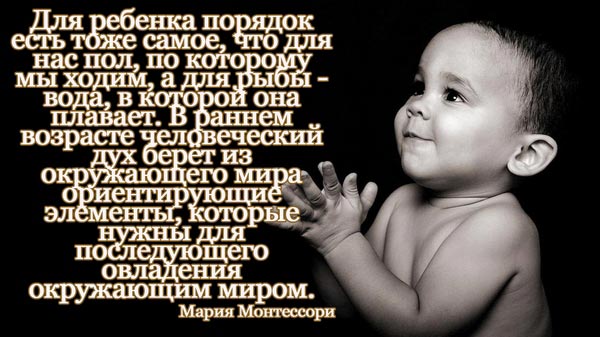
In the kindergartens the groups are divided into several zones and are filled with a variety of didactic aids. Such zoning helps educators to organize working space and maintain order, and children are better able to navigate in a variety of materials. So, more about zoning:
- Practice zonehelps children to acquire simple household skills. For example, children from one to three years old learn to sweep the floor with a scoop with a scoop, to fasten and unbutton buttons of various sizes, velcro closures, to dress and undress dolls. Children from three to eight years old learn to clean shoes, wash and iron clothes, wash and chop vegetables for salads, and even polish metal objects.
- Sensor zoneincludes items that differ in shape, size, color and weight. Games with similar materials (foam balls of different diameters, a set of lids of different sizes for jars and bottles) develop the motility of hands and fingers in children, tactile sensations, as well as mental processes - memory and attention.
- Mathematical zone consists of materials that help kids learn to score, get acquainted with the mathematical symbols and geometric shapes. For kids selected models geometric bodies. Older children study mathematics with the help of accounts, wooden tablets with examples of calculations, sets of figures that give an idea of \u200b\u200bfractions. Solving such tasks, the child also improves abstract thinking, fosters perseverance.
- In the language zone The crumb will find aids designed to learn letters and syllables, expand vocabulary. For example, textured letters, boxes with pictures of “What is this?”, “Who is it?” For the smallest ones, as well as a box office of letters and syllables, sets of printing and capital letters, the book “My first words” for older children. With their help, children learn to write and read.
- Space zone introduces the universe, the environment, the mysteries of nature and weather phenomena, culture and customs of the peoples of the world. Young children are waiting for figures of various animals, and older preschoolers are engaged in maps, collections of minerals.
A photo:
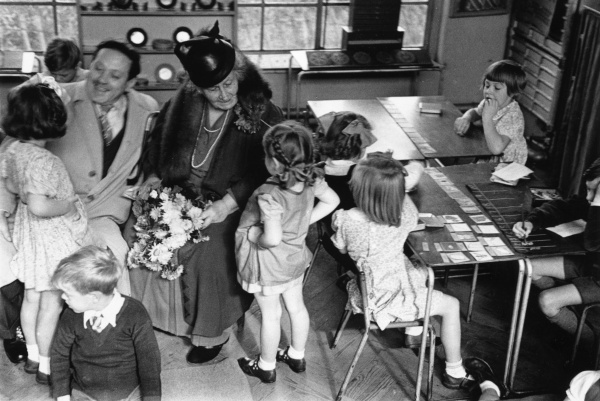
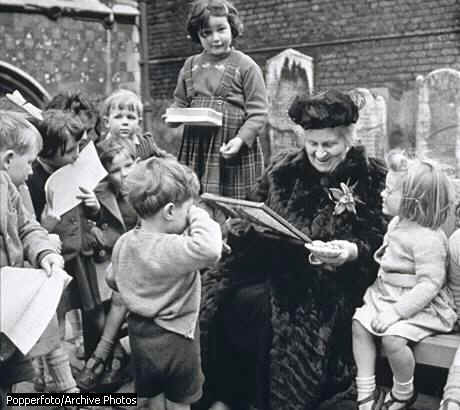
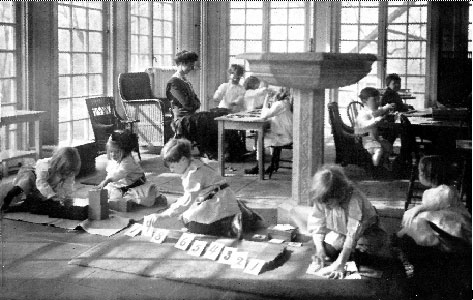
Controversial points in the Montessori method
The main advantage of the Montessori method is that the child develops independently, at his own pace, without any special intervention from adults. As for the significant drawbacks of the methodology, experts refer to the following:
- Most benefits are aimed at the development of fine motor skills, logical and analytical thinking, intelligence. The creative and emotional realm is almost unaffected.
- There are no plot-role and outdoor games, which, in the author's opinion, only inhibit the intellectual development of the baby. But scientists proved that the game in preschool childhood is the leading activity. A child learns about the world, human relationships, playing and interacting with peers.
- Psychologists advise moms of shy and reticent children to be very careful with the Montessori method. It assumes significant autonomy, and quiet kids are unlikely to ask for help if they suddenly can not do something.
- Teachers note that after the democratic atmosphere prevailing in Montessori groups, the child has difficulty getting used to the rules of ordinary kindergartens and schools.
Currently, development centers and many educational institutions Do not practice the Montessori method in its original form. Modern teachers take from it only the bestby adding your own work.
Conversation with the Montessori System Specialist in Early Childhood Development:
Our opinion
The method of early education of the Italian doctor and scientist Maria Montessori is quite interesting and distinctive. Children brought up in montessori classes, independent and self-confident, are able to solve everyday problems. They not only defend their opinions, but are also able to bear responsibility for their own actions. If you have a desire to see these qualities in your child, try to read several books and author’s manuals: “Children's home”, “My method”, “My method. A guide for raising children from 3 to 6 years old "," Help me to do it myself "," A Montessori child eats everything and does not bite "," Self-education and self-study in primary school (collection) ”,“ Children are Others ”,“ Montessori Home School (set of 8 books) ”,“ Absorbing the child’s mind ”,“ After 6 months it’s too late. Unique method of early development " - and take note of some tips on child development and nurturing.
Julia shares her positive and negative aspects of the Montessori technique:
Film about maria montessori
Today, the development of children parents spend much more time than a hundred years ago. For this there are various pedagogical methods that help kids in the very early age not just to grow, but to learn. The Montessori method is what the teaching is, what it is especially about and how to apply it correctly - this will be discussed further.
Terminology
Initially, you need to understand the terminology that will be actively used in the provided article. So, Montessori is not just the name of the method of early development. This is the name of the woman who was her founder. It is Italian Maria Montessori who has prescribed all the principles of her pedagogical teaching, telling how it helps children to better understand the world around them more qualitatively and easily. Back in 1907, she opened her first school, where she helped mentally retarded children to develop qualitatively, sometimes even overtaking peers in their development. At the same time, Maria Montessori did not cease to be surprised: what should be done with normal children, so that they not only did not develop, but even degraded to some extent? It should be noted that today this technique has been successfully applied by various children's educational institutions in 80 countries of the world.
The main thing in the Montessori method
To better understand what is so uniquely given pedagogical doctrine, you need to understand the motto of the Montessori method. This is a rather simple phrase: “Help me do it on my own!”. At this stage, it becomes extremely clear in what key this teaching will develop. That is, the main task of the teacher in this case is to help the child, and not to do his work for him. Here you need to properly understand for yourself that in this method there is an inextricable link between its three main “whales”: the child, the caregiver and the existing environment. The principle is this: in the very center is the child. With all his desires, emotions and dreams. The teacher here is not a teacher as such. He is not a mentor, but only helps the child to know the world in which he is currently located. The purpose of an adult is not to show how it should be (the child may have his own views), but to help if the baby needs help. At the same time, it is completely without a point of reference to this or that moment. The main thing in this technique is not to interfere with the creative energy that crumbs possess at an early age. That it is a huge motive force of its development and knowledge of the world. As a small conclusion, I would like to note that the main goal of this pedagogical teaching is not to make the child a clever little man. The baby should be raised by such a person so that he would be interested in learning something new, learning about the world around him more and more.
On the directions of development of the baby
Realizing that Montessori is a special system for the early development of the crumbs, it is also important to indicate in which directions this knowledge will work:
- That is, the baby knows the world around him with the help of his senses: hearing, sight, smell, and a tactile component. Depending on this, he forms the concept of the form, color and other features of the objects around him.
- Great attention is paid to the development of speech, the activation of speech centers in the brain. For this, a special emphasis is placed on improving fine motor skills.
- Very important in the Montessori method is the acquisition of practical skills.
- The development of mathematical abilities is very important in this teaching.
- And, of course, the child is being developed in the field of the most necessary knowledge - about the world and the environment. The babies are given the concepts of what height is, length, weight, etc.
About the periods of development
The Montessori system is such that it has specific recommendations for each age period. In short, conditionally the development of a child can be divided into three large phases:
- From birth to 6 years old - this is the first phase. It is here that the formation of the child’s personality takes place, at this age his basic abilities are manifested. This period is unique in that at this time the child absorbs everything like a sponge. At this time, it is important to give the correct material for the assimilation of his baby.
- The second phase - from 6 to 12 years. In this period, the main thing is the sensory development. The baby becomes very sensitive and receptive. Phase is also characterized by increased concentration of attention. A child for a long time can concentrate on what he is really interested in without being sprayed on other actions.
- Adolescence, or time from 12 to 18 years. At this hour, the first and foremost is getting personal experience. This is a time of experimentation and, of course, mistakes.
What are sensitive periods?
But in addition to the three large phases, the Montessori system has an idea also about This is a time of special perception of children to a particular activity. These time periods are very important in this method, since they help to acquire certain knowledge more easily and qualitatively.
- Teaching speech skills. This time from birth crumbs. Active phase - up to 6 years of age. Speaking generally, it lasts throughout life.
- The period of sensory development begins at birth and ends at about 6 years of age. But only its active phase.
- From birth and up to three years, the baby has a perception of the order. Not only cleanliness in the house, even more - certain rules of life. For example, in the morning you need to get up and wash.
- From 1 year to 4 years of age, the motor activity develops. This is also the period of gaining independent experience.
- And from 2.5 to 6 years, the development of a wide variety of social skills. It should be noted that in this period, the child laid the norms of rude and polite behavior, which he will use throughout his life.
In fact, the Montessori development method has much more data periods. They are more accurate and specific. So, for example, the ideal time for learning to write is a period from 3.5 to 4.5 years, and reading from 4.5 to 5.5.
Principles of Montessori Technique
The fact that Montessori is a method of early development has become quite clear. I definitely want to tell you about the principles on which this pedagogical teaching is based. It must be said that all the most important is already said in the motto of the methodology. Based on this, the principles of the doctrine are as follows:
- Self-education, self-development and self-study are the most important in the methodology.
- The teacher must respect the child’s personality, his or her characteristics and unique abilities. In no way can they be transformed or moreover destroyed.
- The child makes himself. And only due to its activity it is formed as a person.
- The most important period of the development of the baby is from birth to the age of six.
- Children have a unique sensual and mental ability to absorb everything from the environment.
Maria Montessori says that it is not necessary to accelerate the development of the baby. But here it is very important and not to miss the moment when the crumbs need to be helped to form certain knowledge. A lot of information does not happen. But from her baby will take exactly what he needs at the moment.
Materials for child development
What else is important to tell, studying the Montessori method? Materials that will be necessary for the development of the baby. What will have to stock up on parents who wish to develop the child according to this pedagogical knowledge? It should be noted that in this case there will be no random toys. All didactic materials are well thought out, prepared, made from quality wood or fabric. They are pleasant to the touch and externally attractive to the baby. So, toys are very, very much. For example:
- Lacing frames. They can be very different. Called to teach the child to use household items, for example, clothing. Frames can be on the laces, on the locks, on the rivets and buttons.
- Ladders steps, turrets. They teach the baby to understand what is more and less, thicker and thinner.
- Sticks. Teach such concepts as long and short, longer and shorter.
- Colored signs. Called to teach the baby colors and shades. There are different sets for the little ones and for the older guys.
- Sets of geometric shapes. Learn the basics of geometry.
- Cylinders that are very popular with the youngest children. They have different variations. In one case, the cylinders can be arranged in colors and sizes, in the other - inserted into molds in size.
- What else is rich Montessori technique? Materials that are important for the development of children are signs with rough letters. So, the child takes the first step towards learning to read and write.
There are also wooden sticks, beads, puzzles. And a lot of interesting and useful things that will definitely interest and entice the baby.
What does a Montessori garden look like
Naturally, if there is a teaching, then there are educational centers operating according to this method. What does a Montessori (garden) look like? First of all, this educational institution will adhere to the principles of the International Montessori Association:
- In the room order. Clean reigns everywhere. No scattered things.
- All furniture is suitable for the growth of children who are in a group. All necessary items within their reach.
- In such gardens babes different ages. Groups are mixed.
- An important point: all didactic materials are provided in one version. This is often broken. But the technique involves the order in the training of children.
- In the room where there are children, quietly, calmly, no one swears and does not cry.
- Older children help their lesser comrades.
- The object that the child takes from the shelf immediately returns to the place after the game.
- What else is unique Montessori (garden)? The teacher (in this method they call him “mentor”) does not tell the children what to do. He watches babies from afar. Or conducts group presentations. For example, how to move the chair or unzip the jacket.
If the classes are held on a schedule, the children are told what to do, the kids are noisy or they are bored - this is not a garden or even a group that is trained according to the Montessori method.
What are the principles of the Montessori schools?
Having understood how the Montessori garden should be organized, I also want to tell a little about how the same schools work. How do they differ from other educational institutions? First of all, it should be noted that the Montessori school is unique in that there are no school desks or a lesson schedule. Instead, there are tables and chairs, floor mats. All this is easily transported and transported for the organization of the space of kids. In these classes, the teacher is not the principal. He only helps kiddies. The task of the teacher in this case is to help the student organize the activity he chose for himself. The Montessori School involves the allocation of several zones in one class:
- Sensory, where the work includes hearing, vision, smell and tactile feature.
- The zone of practical life, where the child learns that it is useful in life.
- Mathematics area.
- Native language zone.
- Space zone This is the term of the founder of this teaching, Maria Montessori. Means zone of natural science education.
So, the student himself chooses the area of \u200b\u200bstudy and the specific material with which he wants to work. It is also important to note that Montessori (pedagogy) involves classes of no more than 15 minutes. And in the classes are kids of different ages. But the grouping is approximately as follows: kids from 0 to 3 years, from 3 to 6, etc.
We use the Montessori method at home
The Montessori technique is an early development technique. It can be successfully used at home. And for that, nothing special or supernatural is needed. Just buy those toys that will help the baby to develop properly and learn about the world. What in this case should be remembered using the Montessori method:
- A child is an independent person from the earliest years. Therefore, you need to buy the baby the clothes that he can wear on his own and without problems.
- The baby needs furniture according to his height: small chairs, tables, cabinets for toys and clothes. He has to lay everything in its place.
- Montessori (center) is always clean, bright and comfortable. The same should be the baby’s room.
- The environment in which the child lives should be safe. No items that may break or otherwise scare the little child. Everything should make him want to touch.
- All items used by the child, in the kitchen, in the bathroom, should be within his reach.
- The child must have their own tools. The broom, a rag for dusting. Any help crumbs should be encouraged.
Montessori pedagogy involves the presence of certain toys. They are also worth buying. Which ones are described above.
Disadvantages of this method
It should also be noted that any method of education has its supporters and critics. This case is no exception. A certain circle of specialists believes that Montessori studies do not at all develop their creative potential. And all because there are no role-playing games, no place for the flight of fantasy and improvisation. The truth here, perhaps, is. However, it is necessary to take into account the fact that this method is already more than 100 years old.
The second discrepancy, which emphasize the attention of critics. Montessori (center) is always distinguished by strict discipline. But at the same time the mentor should not interfere in the learning process. However, here it should be noted that the most different ways. It all depends on a particular person and his
Pedagogical story about educationand child development saved hundreds of names, but on the fingers of one hand you can count the real schools that survived the death of the authors. Maria Montessori is in this honorary series. This happened not only because many of her insights found scientific evidence, but also because Maria found the key to translating her ideas into everyday teaching practice. learningand child development.
The Montessori child development system has been built for more than one day. Maria was friends with the founder of genetic psychology, Jean Piaget, and for some time he personally heads the Montessori Society of Geneva. She corresponded with Sigmund's daughter, the child psychologist Anna Freud. Under their influence, she clarifies the findings of her observations on the patterns by which proper child development. But in many ways she remains a doctor and comes from the physiology of children. Even in the concept of freedom, she puts biological meaning and understands, above all, independence. Using examples from her own teaching practice, Maria proves that an adult can not do something for a baby, but simply should help him act independently, encouraging the physical and child's personal development. After all, the baby gets into our world and sees it alien and unsuitable for his life. He has poor coordination of movements, he is not confident in himself and does not know what to do with the objects around him. A child is dependent on giants, who are called adults, and tailors the world to themselves, without thinking about it. And it is difficult for him to unbutton the buttons on the jacket, tie the shoelace on the shoe, move his chair to a convenient place.
M. Montessori offers already in 2.5-3 years to give the child the opportunity to try to do this and much more independently. The teacher (adult) only helps him. He creates order in those things that are necessary for the proper development of the child, and there are a lot of them. All these cups, trays, sponges and brushes, as well as sticks and cubes, beads and rods, cards and boxes - put them in disarray, they will only cause a feeling of powerlessness before the chaos of the world. Montessori offered to arrange them in a certain strict logic, and to teach the kids from the first day in the classroom to maintain the established order. Not only and not so much, because adults want it, but because it is more convenient for the personal development of the child. Maria generally believes that the order is organic for the baby, but he does not always know how to organize it himself. An adult can create conditions in which order is simple and natural. He does not hold long and exhausting conversations with the child, does not use figurative allegories, the moral of which pops up like a little devil from the box, leaving only a sense of bewilderment. The teacher offers the child to take only one clear rule: "He took, worked, put in place." But so that work would be useful for the upbringing and development of the child, the teacher gives the child a short (2-3 minutes) lesson. On it, an adult shows how to handle objects in order to achieve a result, rather than despairing and not losing interest.
Interest is the first thing M. Montessori highlights in his child development techniques preschool age . The second is an individual approach. This, of course, does not mean that each child has a separate teacher. Everything is a little different. During the free work, each child chooses what he likes to do, and the teacher shows him how to cope with the task.
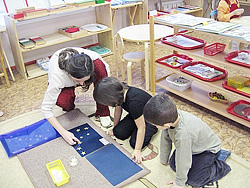 Freedom of choice appears in the baby immediately after he crosses the threshold of the class, because only he himself knows for sure what he needs to develop right now. Although there are some landmarks. So M. Montessori paid attention, and modern psychology confirmed that a child from 0 to 6 years old has periods (from 1 year to 3 years old) when he learns certain things most easily and naturally. So child developmentby Montessori takes place in several stages: from 0 to 6 years the development of speech, and up to 5.5 years of sensory development. On average, from 2.5 to 6 years old, the child develops and consolidates social skills. At this time, children easily perceive forms of polite or rude behavior that become the norms of their lives. And, of course, it is impossible not to say about the short (from 0 to 3 years) period of perception of order. It actually defines the relationship of the child with the world, because it concerns not only the order in the environment, but also in time (the child’s “internal clock” is launched) and in interactions with adults.
Freedom of choice appears in the baby immediately after he crosses the threshold of the class, because only he himself knows for sure what he needs to develop right now. Although there are some landmarks. So M. Montessori paid attention, and modern psychology confirmed that a child from 0 to 6 years old has periods (from 1 year to 3 years old) when he learns certain things most easily and naturally. So child developmentby Montessori takes place in several stages: from 0 to 6 years the development of speech, and up to 5.5 years of sensory development. On average, from 2.5 to 6 years old, the child develops and consolidates social skills. At this time, children easily perceive forms of polite or rude behavior that become the norms of their lives. And, of course, it is impossible not to say about the short (from 0 to 3 years) period of perception of order. It actually defines the relationship of the child with the world, because it concerns not only the order in the environment, but also in time (the child’s “internal clock” is launched) and in interactions with adults.
If one is late and does not take advantage of the opportunities that have appeared to him for the proper development of the child, the child may lose interest in this for life or return the errors and fortuities of these periods in the most unexpected and unpleasant forms after six years.
Montessori urges us not to speed up physicaland mental development baby, but also not to miss the moment and in time to spread a tablecloth in front of the kid on the ground, on which he will see a smaller, safe model of the whole of our world. First, the baby's eyes will run away, and then they will find what he needs here and now. We just need to remember that on our tablecloth are not simple objects, but those that are selected by a long observation of what helps the proper development of children and how. Most of them are collected in a series and are designed for the fact that the baby will be able to touch them, feel their hand, see or hear the differences. So to the limit known only to him, he can develop all his feelings. He can even apply this knowledge by mastering letters that are made of rough paper pasted on planks. Circling them with writing fingers, the child remembers not only the letter itself, but also how to write it.
Surprisingly, if a kindergarten teacher does everything right for the development of children in a kindergarten and his parents do not really interfere with him, the child has an inner need to master and recognize the world around him. It turns out that in order for a child to teach (and better educate) himself, he no longer needs to be punished or encouraged, you only need to throw a coal into his mind’s head in time, and even better to show how and where this coal is to be found.
Maria herself writes: “It is not true that the Montessori teacher is ineffective when an ordinary teacher is active: all activity is ensured by the active preparation and guidance of the teacher, his subsequent“ inactivity ”is a sign of success.” The main task of an adult in the Montessori child development method is to help children learn to focus on the work they are interested in. In this difficult matter the teacher goes through three stages. The first is the preparation of an attractive environment for the baby and a comfortable environment. The second is the destruction of the activities of individual children, which hinders the advancement and development of others. At this difficult stage, the teacher shows the naughty boy that he is loved even by such a restless and unbearable and at the same time tirelessly helps the kid to find something that will interest him and help him concentrate on his work. The energy of the child is redistributed from indiscriminate splashing to constructive activities aimed at comprehensive child development. At the third stage, the teacher is most important not to interfere with the child, not to disrupt his searches and his work.
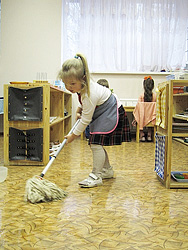 Most of the teacher’s effects occur indirectly, through the environment or through the rules that he comes up with with the children. The whole appearance of an adult and his enthusiasm captures children and helps the teacher to build trusting relationships with each child, to create the unique atmosphere that distinguishes the classes where the child’s Montessori development takes place.
Most of the teacher’s effects occur indirectly, through the environment or through the rules that he comes up with with the children. The whole appearance of an adult and his enthusiasm captures children and helps the teacher to build trusting relationships with each child, to create the unique atmosphere that distinguishes the classes where the child’s Montessori development takes place.
Maria noticed that children teach other children better than adults, and in our adult life we \u200b\u200bcommunicate with those who are older than us and those who are younger. Using this observation in her method for the development of children of preschool age, Maria filled her classes with children of different ages by selecting two groups. In the first - children from 3 to 6 years, in the second from 6 to 12. They have different tasks. Up to six years, the child builds his mind, and after six, he actively develops culture. And if the children grow wiser, each at his own pace and to his limit, then the culture can still be developed in different forms and directions.
It is much more difficult to organize assistance to the second group; therefore, there are considerably less classes for children from 6 to 12 in the world than classes from 3 to 6. And yet in some countries (USA, Netherlands) Montessori child development schools are quite a lot.
Mostly these are countries where there were no totalitarian regimes with which M. Montessori’s pedagogy did not get along anywhere in the world. After all, dictators do not need responsible, independent and self-thinking individuals who are brought up and developed in children in classes in Montessori classes.
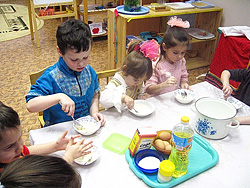 By the end of the thirties, a new motive appeared in the pedagogical system of child development according to Montessori. Everything that happens in the world, M. Montessori believes, is determined by the cosmic plan. The Creator "writes" him, and He endows man with a special mission. People are led along the path from an apprentice who fulfills the will of the Creator to the heights of skill. Already now, such an imperfect person, the only being endowed with reason, is responsible for everything that happens in the world. But in each of our lives, a conflict arises between our cosmic task and what we do under the influence of sociocultural conditions and learning.
By the end of the thirties, a new motive appeared in the pedagogical system of child development according to Montessori. Everything that happens in the world, M. Montessori believes, is determined by the cosmic plan. The Creator "writes" him, and He endows man with a special mission. People are led along the path from an apprentice who fulfills the will of the Creator to the heights of skill. Already now, such an imperfect person, the only being endowed with reason, is responsible for everything that happens in the world. But in each of our lives, a conflict arises between our cosmic task and what we do under the influence of sociocultural conditions and learning.
M. Montessori perceives a small child as the most “pure” carrier of the Creator's intention. Then the main task of adults is not to destroy this plan with their intervention. These ideas are not always perceived by those who undertake to work on the system of M. Montessori. Nevertheless, they are quite organic for teaching and developing a child according to the method of Maria Montessori and give it slenderness and completeness.
